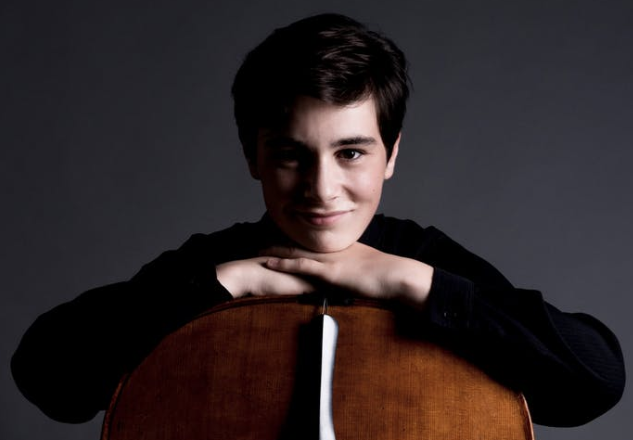Creative Classical Concert Management presents Rising Artists Series: Aleksander Simic in Review
Aleksander Simic, cello
Tatiana Goncharova, piano
Weill Recital Hall at Carnegie Hall
Tuesday, February 25, 2020, 8 PM
By any standard of measurement, 16-year-old Austrian-born cellist Aleksander Simic (his parents are Hungarian-Serbian) made a very impressive recital debut on Wednesday in New York. Sixteen, let’s let that sink in. Although his program was conservative chronologically (all nineteenth century), it contained two demanding standard repertoire masterpieces, and two showpieces, all played with sweet tone, sufficient, sometimes awe-inspiring, technique, and an un-showy focus that is often rare in young people. Mr. Simic was ably assisted by the hyper-refined pianist Tatiana Goncharova, who was the picture of deference, providing a plush red carpet for Simic to walk on. My only reservation, aside from the short-stick used on the Steinway, was that perhaps she was too deferent, a common enough concern in cello-piano recitals. Fear of balance however, sometimes made her well-phrased contributions take a back seat to the soloist rather than sound like strands fully participating in the musical conversation. She did break out fully late in the program, to my great pleasure (see below).
The recital began with the treacherous Sonata in A minor, D. 821, the“Arpeggione.”. This work, written for a now-extinct instrument (except for museum collections), is almost always played on the cello. Poor old arpeggione, a six-stringed instrument, fretted like a guitar but bowed like a cello. The fear in modern cello performances (which have four strings) is that the work will become a strenuous acrobatic display; its reaches into the upper notes of the instrument are relentless, yet they must sound lyrical and ‘easy.’ Mr. Simic gave us no cause for apprehension—in fact, his handling of the high registers was assured all evening. The lyricism so crucial to this work’s success was revealed so sensitively, my only concern was that there was a certain emotional distance, it seemed almost too reserved, though lovely.
Next came one of Paganini’s ‘trick’ showpieces, originally for violin. The legend dates back to Paganini’s manic touring in early nineteenth century Europe. He’d play so violently that he’d break one of his strings, continue the recital with just three strings, break another one, continue with two, then break that one and continue with just one string. Of course, all this was figured out way ahead of time, but nonetheless impressive. The Variations on One String on a theme from Rossini’s Mosè in Egitto is that piece, and it still stuns when given a passionate run-through on the cello. Here, Mr. Simic showed his ebullience, both in the lyric line and the busy interrupting cadenzas (a quality we would hear later in the program as well). The lavishly printed and photographed program that was distributed didn’t even mention the ‘one-string’ part of the title, and I’m not sure the nearly sold-out audience even realized what an achievement they were hearing.
After intermission, the duo returned with Brahms’ great Cello Sonata No.1 in E Minor, Op. 38, the fruit of his incessant study of baroque counterpoint, in this case Bach’s magisterial summation: Die Kunst der Fuge. The first and third of the three movements are based on permutations of themes from it. (There was a destroyed Adagio movement at one point, what a loss!) Here Mr. Simic stepped fully into the music, and he showed a great deal more emotional vividness (his eyes also traveled a bit more toward the score, which he had ignored completely in the first half). His sound, it was very good to note, changed and became much more appropriately muscular. In the first movement, I wished for more left-hand sound from Ms. Goncharova (see above), as it contains a lot of motivic content, but in the difficult fugal finale, both players really “let it rip,” providing the most satisfying combination of the evening.
Then came the final showstopper, David Popper’s Hungarian Rhapsody, Op. 68. Any number of pianists would recognize at least two of its themes, they served Liszt well in his own Hungarian Rhapsodies. Nowadays it is “politically correct” to note that this genre of work bears no resemblance to authentic Romany music; they are westernized versions, music played by strolling “gypsy” violinists in cafes, using some stereotyped gestures and melodies. But why let that get in the way of our enjoyment, especially when they’re in the hands of such a gifted player as Mr. Simic? Here, he let his impish side come out a bit more (though his focus and concentration never called attention to himself), and the work certainly thrives when the player “winks” at the audience as if to say: “See, not only can I do that, I just did it.” The alternations of lassu and fris, interspersed with crazily florid cadenzas testing every harmonic, were spooled out in masterly fashion. The hall went wild, and deservedly so.
Mr. Simic and Ms. Goncharova favored us with Elgar’s Salut d’amour (another violin original), which was sweetly played. He is sixteen after all, and I suspect that there will be more, shall we say, ‘subtext’ to a morceau like this as he grows and matures. A very impressive player though, also photogenic (which is important), and definitely a “rising star.”

